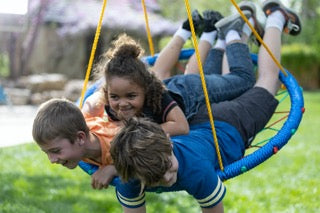Using Physical Activity for Interactive Learning

We loved this insightful article on using physical activity as a resource for kids to learn in an interactive way. At Bolder Play we are passionate about encouraging kids to stay active. Not only does an active lifestyle keep kids healthier, it helps them see more success in academics and other areas of life.
Here's what Frankie has to say about learning through physical activity.
Interactive Learning through
Physical Activities

Over the last few years, the accepted definitives of the education sector have changed significantly. Strongly-held methodologies have begun to be questioned, and there has been a dramatic shift from a pedagogy confined entirely to the classroom, to a series of more dynamic and engaging approaches.
Interactive learning through physical activity is a new methodology that has gained a large amount of traction in recent years. This innovative approach to education has opened up a range of new possibilities when it comes to early years development, offering improvements across the board in physical health, cognitive development, social skills, and overall academic performance.
Interactive learning through physical activity offers a far more open, accessible way to teach your kids, and is something that can continue wherever you are in the world, not just during traditional school hours. Whether at school, at home on the weekend, or on vacation on a 3-day cruise on an amazing ship, interactive learning through physical activities can be weaved into the fabric of everyday life.
The Concept of Interactive Learning
Let’s start by taking a look at what ‘interactive learning’ actually means. This methodology takes a different approach to the traditional educational consensus, moving away from passive learning based on students receiving and analyzing information and trying to create more active engagement between pupils and their learning materials. Interactive learning can be a whole host of different things, from group projects and hands-on experiments to discussions and even physical activities.
Benefits of Physical Activities in Education
Enhanced Cognitive Function
Packing more exercise into education has been demonstrated to help drive cognitive performance and improve brain function. There are a wealth of research papers which show that physical activity promotes blood flow to the brain, which helps with a variety of functions such as memory, attention span, and problem-solving.
Improved Academic Performance
Scientists have been studying the degree to which this enhanced brain performance correlates with academic achievement, and the research largely shows a strong link between physical activity and better grades. Students who exercise as part of their educational development tend to show better outcomes across the board, from attendance to concentration, as well as when it comes to test scores. As a result, incorporating interactive learning that includes physical activity can have huge benefits academically for kids.
Development of Social Skills
Alongside improved academic performance, incorporating physical activity into a course of interactive education can drastically improve students’ development in other areas, such as social skills. Physical activities can teach things like teamwork and cooperation, as well as communication, conflict resolution, and collaborative workings, which make them invaluable not just in terms of grades but for general life skills for the future.
Enhanced Physical Health
Of course, it goes without saying that regular exercise is a crucial part of overall physical health as well, which is another important aspect. From reducing the risk of obesity to preventing disease, adding physical activity into the educational mix is an all-round winner.
Challenges and Considerations
It is, of course, important to consider the challenges that interactive learning that includes physical activities can pose as well as the benefits. Certain steps will have to be taken by schools and parents to ensure that all students have access to this learning method, regardless of their skills or physical abilities. It is also important to ensure that the healthy competitiveness of sports and exercise doesn’t spill over into something less positive. Finally, teaching staff may need to be trained further in order to be able to integrate these activities into their teaching style effectively. Additional resources may be required, so it is worth thinking ahead, but the benefits make this approach a hugely positive way to go!

A big thanks to Frankie for sharing her writing with us! Check out more of Frankie's work at https://apopsiclestand.com/.
To find the perfect indoor and outdoor toys to keep your kids active, browse our collections at www.bolderplay.com.













This blog compellingly illustrates how integrating physical activity into learning enhances cognitive function, academic performance, and social skills.
Including physical activity into learning improves engagement, focus and retention. It perfectly fitting with Montessori’s hands-on movement-based teaching approach.
This post perfectly highlights how physical activity enhances learning! Engaging in movement-based education leads to better focus, creativity, and growth.
Hey there! Bolderplay’s blog post is all about making learning fun through movement. It has cool ideas to get kids active while they learn. Pretty neat stuff!
Leave a comment